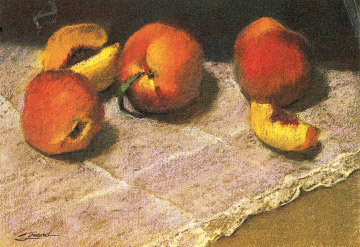The art of culinary paintings
by Tissa Hewavitarane
When you are choosing a culinary still life subject, the first thing
to remember is that you don't necessarily need a huge variety of
objects. But if you want to make the most of the textures, you need some
contrast.
A bowl of mixed fruits, such as apples, oranges, mangoes or grapes
would provide a variety of textures. Also try to choose objects to paint
that really excite you and challenge in terms of technique.
Fine paintings can be made from very simple subjects such as one or
two apples on a rough wooden table. Don't decide to draw or paint
something just because it is there. Go to the supermarket or a grocer
and have a look round for inspiration.
|

Some of the peaches have been cut to show a greater range of
texture. |
The less familiar you are with the subject the more closely you will
have to look at it and consider the best way of tackling the textures.
In the past, vegetables were less popular than fruit as still life
subjects, perhaps because they do not appeal to the taste buds in the
same way.
Nowadays, however, more and more artists are discovering their
possibilities and if you look at the range of textures, colours and
shapes, you can see why.
A few examples are the thin-skinned subtly coloured onions, the
delightfully crinkly savoy cabbage and green and black pepper. Some of
the best advice I was ever given about still life was to study the range
of food and objects on a table during or after a meal.
Whether it is a boiled egg and slices of toast or fruits, the range
of subjects seemed endless.
The rather haphazard arrangement of the food and other objects often
suggested interesting and natural-looking compositions. In general a
still life should not look too “posed”.
For the beginner it is always best to start off with a limited number
of objects perhaps no more than five or six and to arrange them in a
simple composition.
In choosing the objects for the painting pay special attention to the
contrast and balance of different textures.
Media and methods
Although many textures of fruit, vegetables and food can be rendered
equally effective in a number of media, it is worthwhile to consider
their relative strengths and weaknesses by trying out several different
ones. Pencil and coloured pencil drawing fruit and vegetables can be an
excellent introduction to the idea of representing texture.
The wide range of different levels, in particular testing your
ability to adopt your drawing style to suit the subjects. The pencil is
one of the most versatile of all drawing implements, offering an almost
infinite range of marks and effects which will suit most approaches and
styles.
If you want to explore the more suggestive possibilities of pencil,
don't sharpen it all the time, experiment with a worn rounded
soft-leaded pencil or even a charcoal stick to broaden your range. For
those who find it difficult to draw fruit and culinary subjects in
monochrome coloured pencils can be an exciting alternative.
They can be used in similar ways to the pencil but are also capable
of some marvellous colour effects. To get the most out of them be sure
to use paper with a slight grain so that you can build the drawing. If
the paper is hard and smooth, the colours will take depth and the result
will look rather thin.
Pastel
Soft pastel is a wonderfully sympathetic medium for drawing soft skin
fruit such as peaches or apricots. The vivid colours and opaque, matt
surface perfectly recreate those of the subject. The dry, crumbly nature
of pastels also make them highly suited for rendering food which have a
similar texture, such as cakes bread and biscuits.
One thing to remember about pastels, however, is that the effects you
achieve depends very much on how you use them.Blending colours together
with a finger, a piece of cotton wool, or a special implement called a
‘torch’ on (a very tight roll of paper with a point at one end) will
produce a such an effect, with colours and tones merging together almost
imperceptibly.This technique is well suited to smooth objects with matt
or shiny surfaces such as eggs. You do not have to stick to one method
throughout. You can also let the paper help you describe texture.
Pastels can be done on white paper, but coloured surfaces are normally
used because it is difficult to cover the surface completely and specks
of white showing through the pastel marks tend to directract from the
picture. Pastel can be used to convey detailed and complex textures and
colourings.
Working with oil
Oil paint is such a versatile medium, with the possibility of
rendering so many textures in such variety of ways, that is almost
impossible to choose any one technique over another as particularly
suitable for culinary subjects. However, a general rule is to try to use
the paint so that its physical nature has some affinity with that of the
subject. You cannot do this with either watercolour or pastels, which
have their own uncompromising natures, but oil paints are endlessly
adaptable - they can be used thin and semi-transparent, with almost
invisible brush marks of thick and oily brush strokes.
Tips to remember
* When painting in pastels or oils keep your highlights and darkest
shadows to the end.
* A sharp and well-defined highlight indicates a smooth surface, a
soft and diffused light shows a rough or soft surface.
* Do not be afraid to mix the media. If you are working with colour
and cannot capture the soft bloom on fruit try a touch of pastel on top. |

